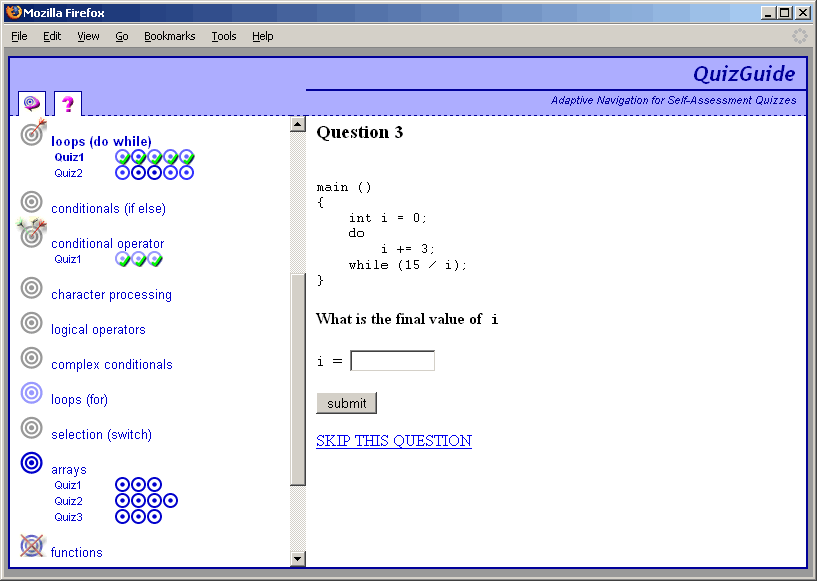Difference between revisions of "QuizGuide"
(→Interface) |
(→Interface) |
||
| Line 1: | Line 1: | ||
| + | QuizGuide (Brusilovsky et al., 2004), an adaptive front-end to a collection of interactive self-assessment questions in the domain of C programming. The domain model in QuizGuide is formed by 22 topics such as variables, constants or character processing (Figure 3a). The system is able to model learner knowledge independently by topic and visualize the state of this learner model through adaptive annotation of link using the “target-arrow” icons (Figure 1). The number of arrows in the target reflects the level of knowledge the student has acquired on the topic: the more arrows the target has, the higher the level of knowledge. The intensity of the target’s color shows the relevance of the topic to the current learning goal: the more intense the color is, the more relevant the topic. This interface combined successful features of open learner models and navigation support: it provides a clear presentation of student knowledge by topic while also helping the student to select the optimal topic to work (one that is ready to be explored, but still not mastered). | ||
| + | |||
| + | Despite a relatively simple adaptation approach, the navigation support provided by QuizGuide resulted in a remarkable impact on student performance and motivation to work with the system. In comparison with QuizPACK (Brusilovsky & Sosnovsky, 2005b), an earlier version of the system which provided access to the same quizzes with no navigation support, the average knowledge gain (a difference between post-test and pre-test results on a 10-point test) for the students using QuizGuide increased from 5.1 to 6.5. By guiding students to the right topics at the right time, the system caused a significant increase in the percentage of correctly answered questions from 35.6% to 44.3% (Brusilovsky & Sosnovsky, 2005a). Most remarkable, however, was an increase in the students’ interest in working with the system. The number of attempts, the percentage of students using the system actively, and the percentage of attempted topics increased significantly (Brusilovsky & Sosnovsky, 2005a). A re-implementation of QuizGuide’s adaptive navigation support approach for SQL (Sosnovsky et al., 2008) and Java programming (Hsiao et al., 2009) confirmed this impact in two other domains. | ||
| + | |||
| + | |||
| + | == Domain Model == | ||
| + | |||
== Interface == | == Interface == | ||
| − | [[Image: | + | [[Image:Quizguide.gif|QuizGuide]] |
Revision as of 17:25, 27 January 2018
QuizGuide (Brusilovsky et al., 2004), an adaptive front-end to a collection of interactive self-assessment questions in the domain of C programming. The domain model in QuizGuide is formed by 22 topics such as variables, constants or character processing (Figure 3a). The system is able to model learner knowledge independently by topic and visualize the state of this learner model through adaptive annotation of link using the “target-arrow” icons (Figure 1). The number of arrows in the target reflects the level of knowledge the student has acquired on the topic: the more arrows the target has, the higher the level of knowledge. The intensity of the target’s color shows the relevance of the topic to the current learning goal: the more intense the color is, the more relevant the topic. This interface combined successful features of open learner models and navigation support: it provides a clear presentation of student knowledge by topic while also helping the student to select the optimal topic to work (one that is ready to be explored, but still not mastered).
Despite a relatively simple adaptation approach, the navigation support provided by QuizGuide resulted in a remarkable impact on student performance and motivation to work with the system. In comparison with QuizPACK (Brusilovsky & Sosnovsky, 2005b), an earlier version of the system which provided access to the same quizzes with no navigation support, the average knowledge gain (a difference between post-test and pre-test results on a 10-point test) for the students using QuizGuide increased from 5.1 to 6.5. By guiding students to the right topics at the right time, the system caused a significant increase in the percentage of correctly answered questions from 35.6% to 44.3% (Brusilovsky & Sosnovsky, 2005a). Most remarkable, however, was an increase in the students’ interest in working with the system. The number of attempts, the percentage of students using the system actively, and the percentage of attempted topics increased significantly (Brusilovsky & Sosnovsky, 2005a). A re-implementation of QuizGuide’s adaptive navigation support approach for SQL (Sosnovsky et al., 2008) and Java programming (Hsiao et al., 2009) confirmed this impact in two other domains.

